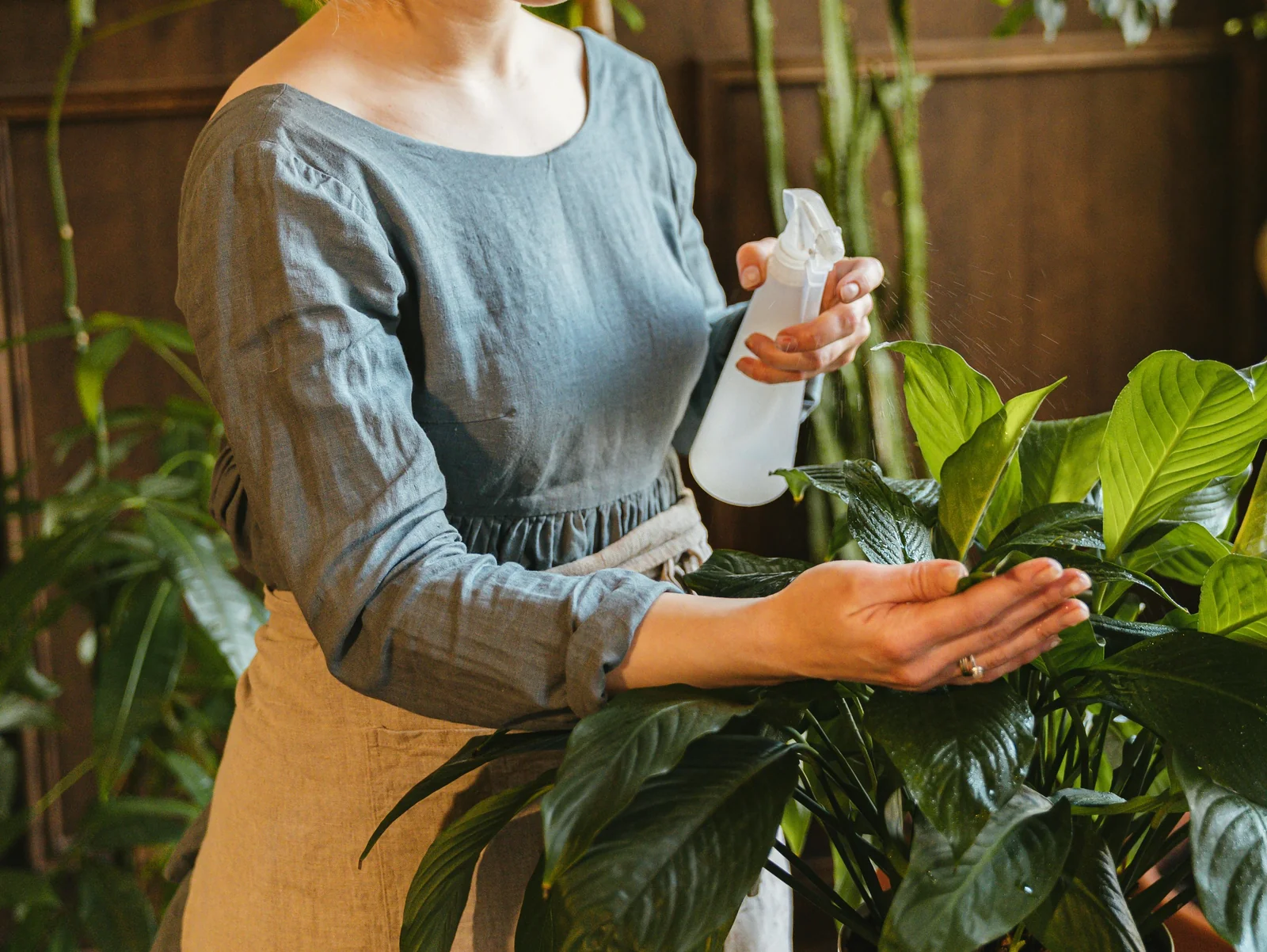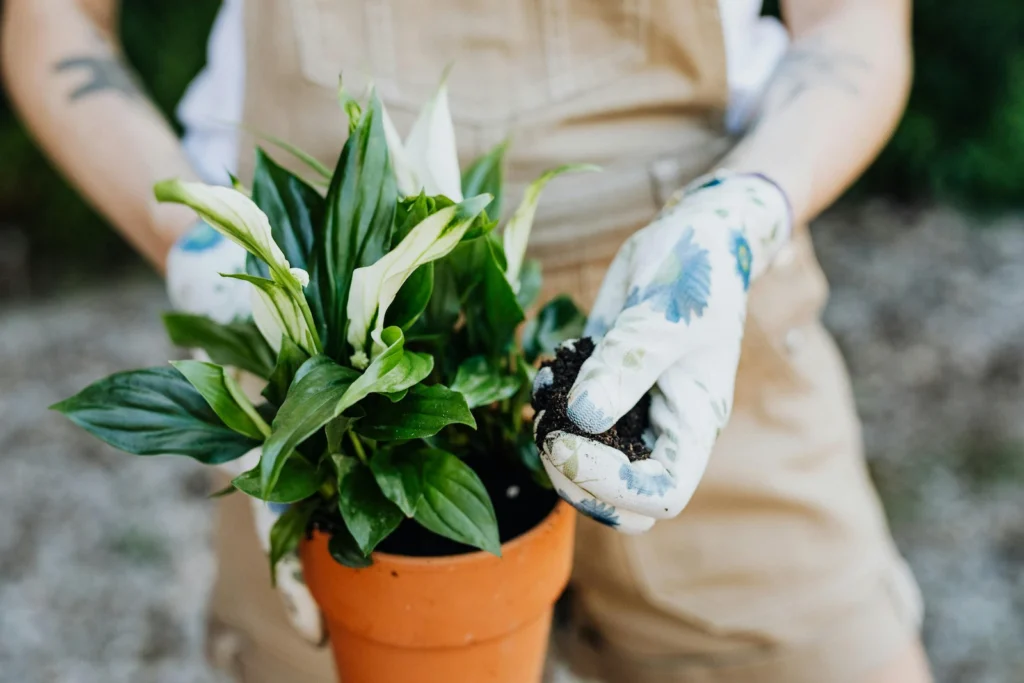
Well, to break it to you, Peace lilies, like many plants, need water to carry out essential biological processes such as photosynthesis and nutrient absorption 😛. Water is that medium which transports nutrients the way it does for human beings. Also, to prevent wilting and yellowing, we need to keep watering the plant so as to avoid dehydration. Now to go deep in science a bit, watering helps maintain turgor pressure within the plant cells, keeping the leaves of peace lilies firm and upright. Peace lilies (Spathiphyllum) are native to tropical regions and thrive in environments with high humidity.
Timely watering helps to maintain the moisture levels in the air (humidity) around the plant which creates a more favourable environment for the growth of these plants. And obviously, if the nutrients are just right with appropriate levels of hydration, flowering can happen naturally when it’s time.
When to water peace lilies?
To determine when to water your peace lily, you can follow a peace lily watering schedule. One simple way to do this is by checking the soil moisture regularly by inserting your finger about an inch deep into the soil. If the soil feels dry to touch at this depth, it’s time to water.
If you notice that your peace lily is wilting or drooping, it could be a sign of an underwatered peace lily. In this case, water the plant thoroughly, allowing excess water to drain away.
On the other hand, signs of overwatering include yellowing or browning of the leaves, mushy or soggy soil, and a foul odour emanating from the soil. An overwatered peace lily can suffer from root rot, where the roots become waterlogged and start to decay. To prevent root rot, ensure proper drainage in the pot and allow the soil to dry out slightly between waterings.
Follow a good watering schedule and monitor the signs of both underwatering and overwatering as described above. This way you can keep your peace lily healthy and thriving.
How much water does a peace lily need?
In general, a peace lily plant should be watered until the soil is thoroughly moistened, and it usually requires about ¼ to ½ of the volume of the pot with draining the excess water. If you don’t want to check moisture by dipping your fingers in the soil mixture, you can use a Soil Moisture Meter (Hygrometer Sensor) which helps to indicate the moisture level in the soil.
How often to water peace lily in summer and in winter?
In summer, peace lilies may require more frequent watering due to increased temperatures and higher evaporation rates. You may need to water your peace lily approximately once a week or every 5 days during the summer months. Monitor the soil moisture and adjust the watering frequency based on the specific conditions in your environment.
In winter, when temperatures are lower and if you have an indoor heating facility, it may reduce humidity levels in the room, and usually peace lilies typically require less frequent watering. During the winter months, you may need to water your peace lily approximately once every 7 to 10 days, or even less often if the soil takes longer to dry out. Again, it’s essential to check the soil moisture regularly by the method stated above and water the plant only when the top inch or so of the soil feels dry to the touch.
How to water a peace lily?
There is no hard and fast rule for watering a plant, especially a peace lily. Here are some pointers anyway –
Direct way
Water temperature: Before watering your peace lily, allow tap water to come to room temperature. Cold water can shock the plant’s roots, while hot water can damage them.
Water thoroughly: When watering, pour water evenly over the soil until it begins to drain from the bottom of the pot. Ensure that the entire root ball gets hydrated, but avoid overwatering, which can lead to root rot. Try to avoid getting water on the leaves of the peace lily, as this can lead to unsightly water spots and increase the risk of fungal diseases.
Drain excess water: Allow any excess water to drain away completely from the bottom of the pot. Peace lilies don’t like to sit in waterlogged soil, so it’s essential to ensure proper drainage.
After watering, check the soil moisture regularly.
Bottom watering
Bottom watering is another method that can be used to hydrate peace lilies effectively. Bottom watering can be particularly useful for peace lilies as it helps ensure that water reaches the plant’s roots evenly without the risk of waterlogging the soil. However, whichever watering method you choose, it’s essential to monitor the plant’s condition and adjust your watering routine accordingly to keep your peace lily healthy. Here’s how to bottom water a peace lily.
Place the pot in a saucer or dish: Set the pot containing the peace lily in a saucer or shallow dish.
Water to the saucer: Pour water into the saucer, allowing the pot to absorb water through the drainage holes in the bottom. Add enough water to ensure that the soil becomes thoroughly moistened. Allow the pot to sit in the saucer for a few minutes (10 to 15 minutes) until the soil is adequately hydrated.
Remove excess water: After soaking, remove any excess water remaining in the saucer to prevent the roots from sitting in standing water.
Can we use tap water or distilled water for watering peace lily?
Yes, you can use distilled water for hydrating the peace lilies.


